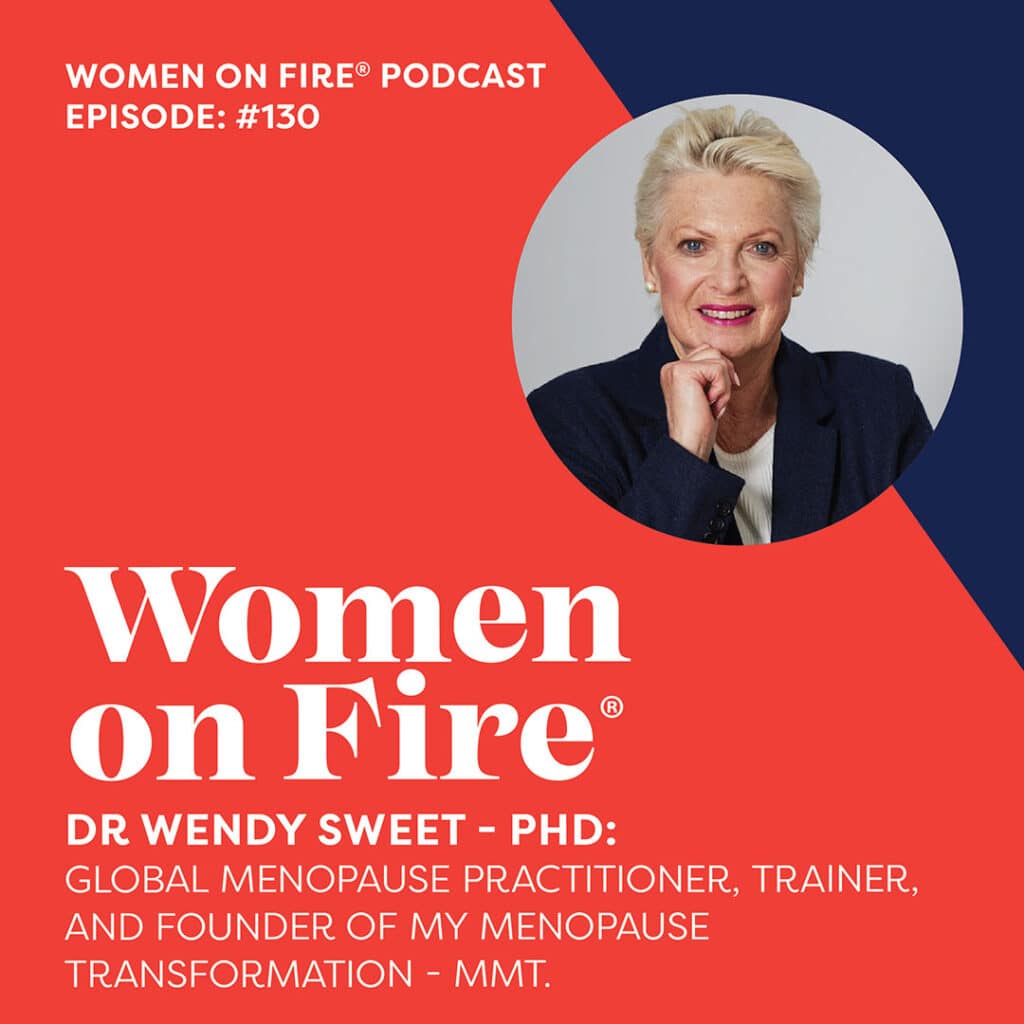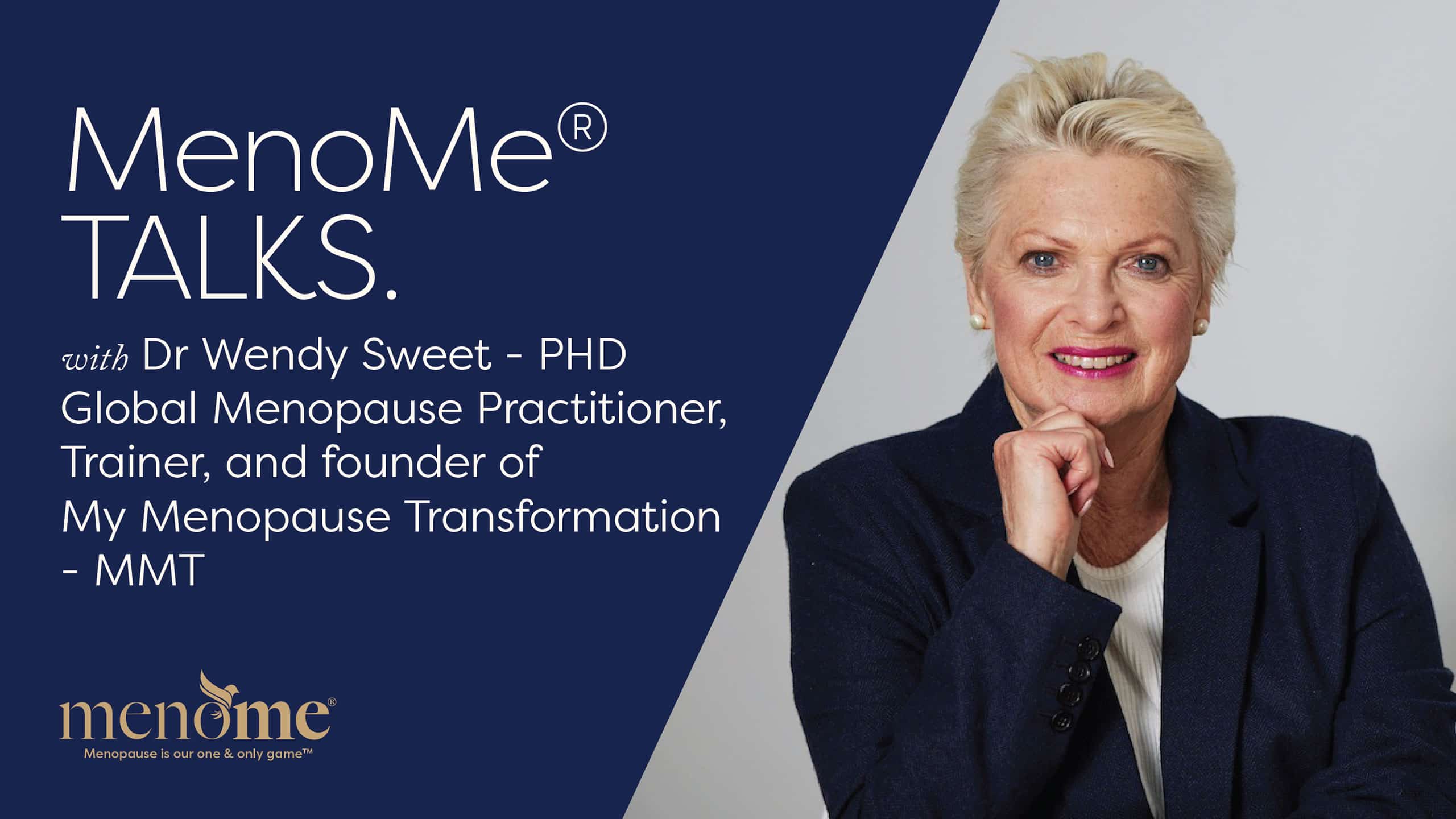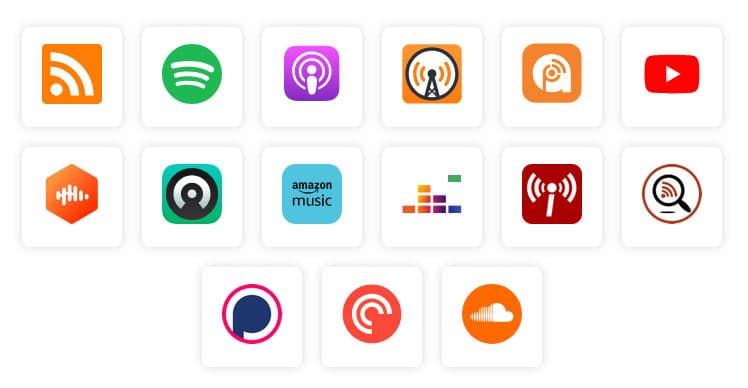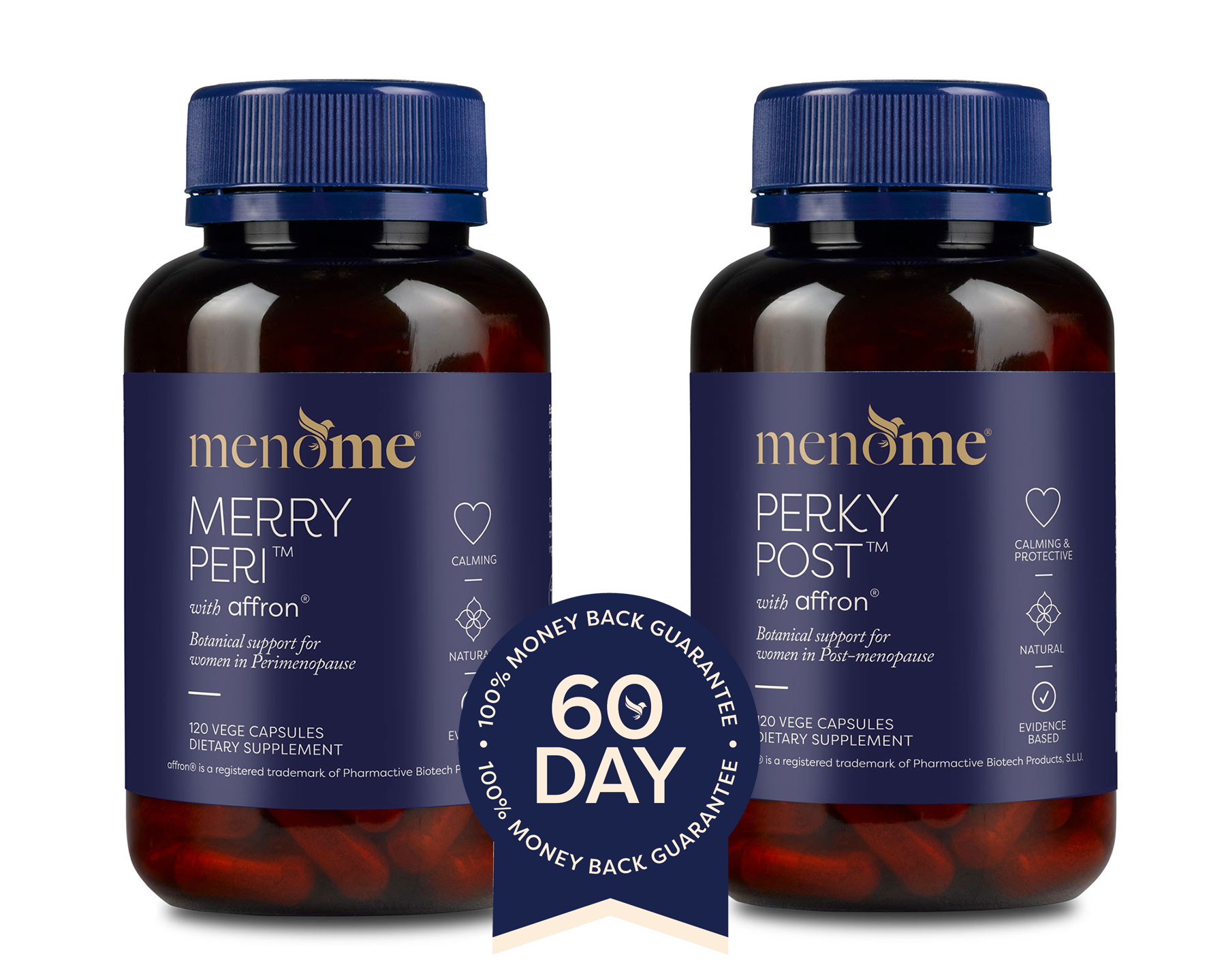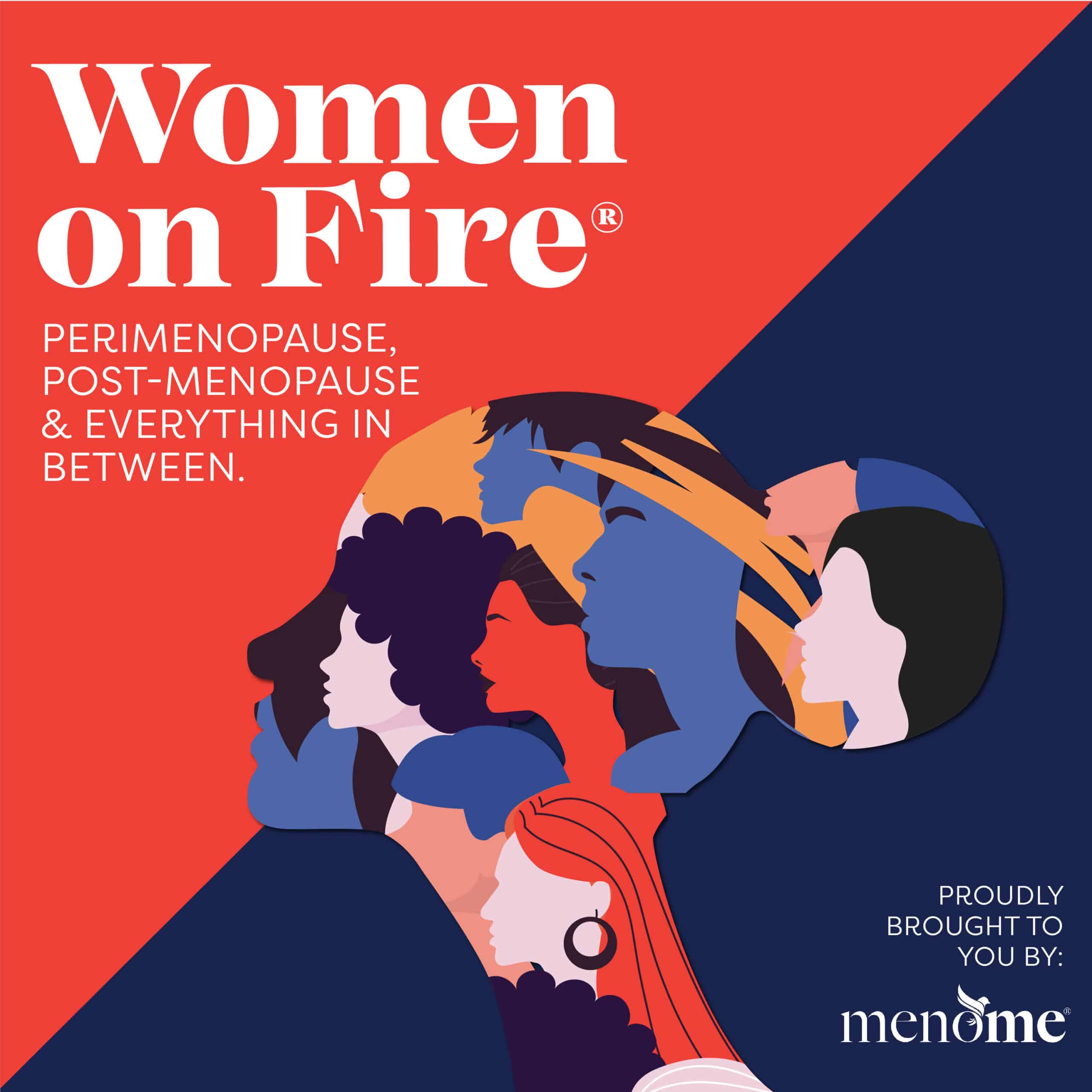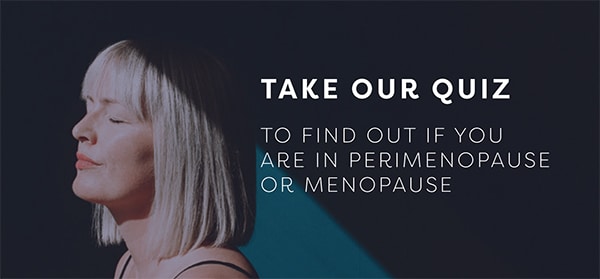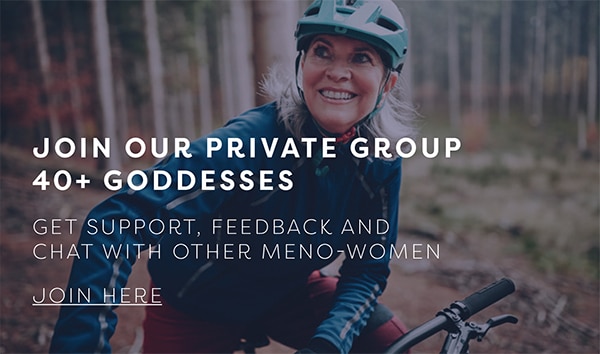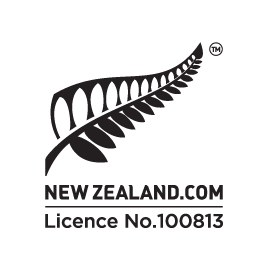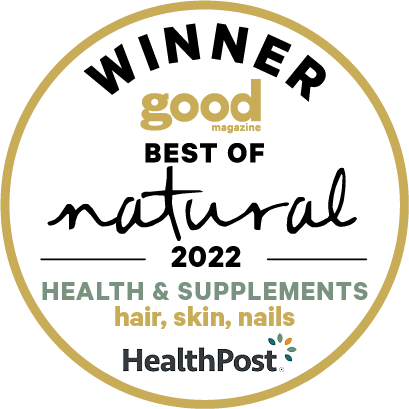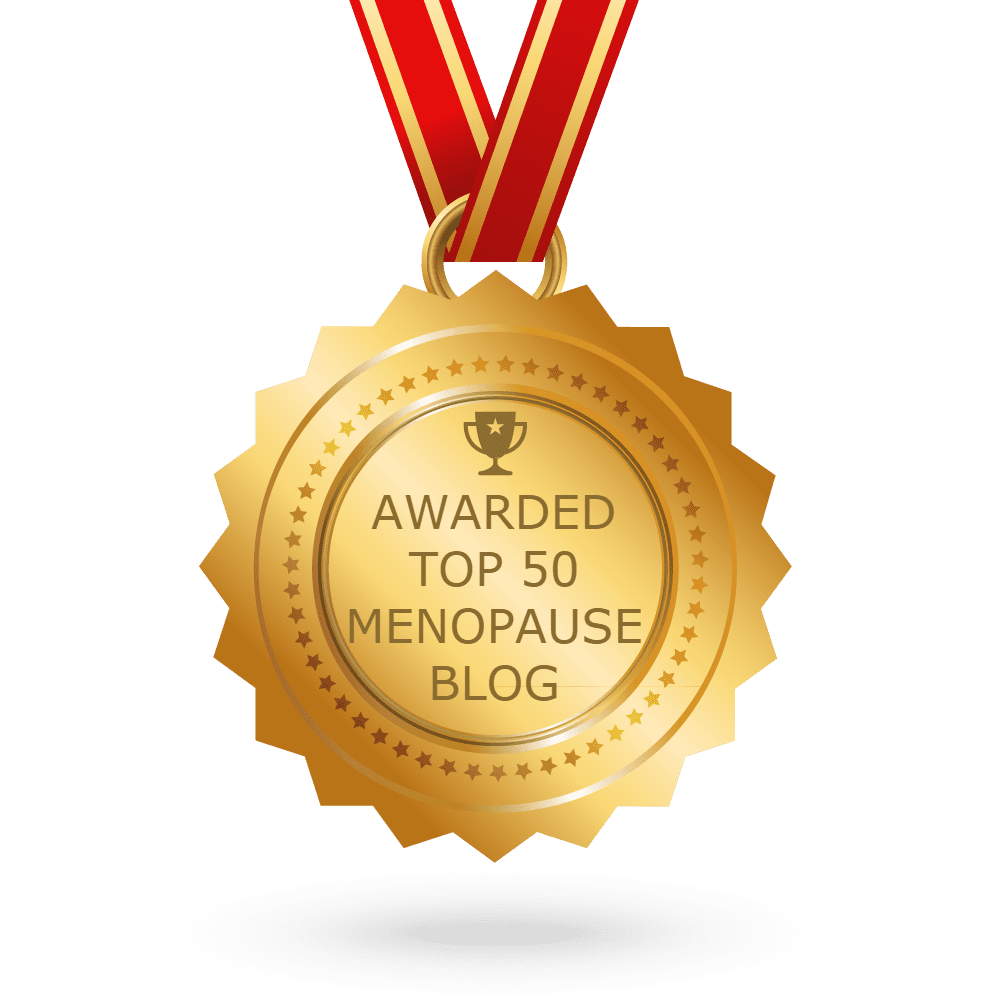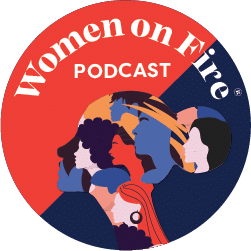Podcast Episode
In this episode, we talk about
- 00:00 Introduction
- 01:04 About Wendy
- 05:42. Wendy’s story
- 10:44 Exercise and depression
- 10:52 Understanding the importance of vitamin D
- 14:23 We aren’t our mother’s generations
- 16:15 Should women be lifting heavier and heavier weights? Is there a best choice of exercise?
- 28:58 Exercise assumption, ageing and menopause
- 33:40. American Heart Association Guidelines
- 37:02 Recovery and blood work
- 40:10 Your muscles are ageing and changing
- 44:32 Do we need to be taking creatine?
- 48:30 Fat gain and meno belly
- 57:05 How much (and what type of protein should non-athletes be eating?
- 59:52 The Keto diet and menopause
- 01:01 The Mediterranean diet and menopause
Episode Resources:
- Follow Wendy on Instagram here
- Follow Wendy on Facebook here
- My Menopause Transformation newsletter here
- American Heart Association Guidelines here
Video Version
Transcript
Jenna
I’m very excited to introduce you to my guest today, Dr. Wendy Sweet PhD. You’re going to want to listen to this episode because not only is Wendy a fountain of knowledge about peri and postmenopause, she’s also an award -winning presenter and educator.
So, to give you a bit of background, Wendy started her career as an ICU nurse. She’s no longer practising. And then she moved to the fitness industry. And in fact, Wendy was one of the pioneers of personal training. And she’s won the Australasian Fitness Educator Author of the Year Award and the Exercise New Zealand Award for Most Outstanding Contribution to the New Zealand Fitness Industry.
Wendy went on to become a university lecturer in the space and while she was there she became curious about how women perceive their aging and the role of exercise during their menopause transition. So she undertook her PhD. As a result, she holds a master’s degree in lifestyle behavior change and a PhD in women’s health and ageing.
So Wendy’s well qualified to talk to us today. She tells the story of how when she embarked on her PhD, she realised she was in perimenopause and struggled with it. Then she heard similar stories from the women she was interviewing for her doctoral studies. So she realised something needed to be done. As smart women do, she pivoted. And her passion and purpose is now supporting and educating both women and health professionals in multiple countries – I think it’s 40 or 50 countries – about menopause through evidenced lifestyle science.
It’s something I’m passionate about too, and it’s now almost a decade since I trained. And that was at a time when menopause, perimenopause, was still being swept under the carpet. Certainly not now.
It’s very much in the mainstream, come out of the closet. And there’s a lot more research coming out every day, which is exciting. And even though I’m in this space every day and I’m constantly updating on the latest happenings and the latest research, I felt like I needed to add more layers and undertake more formal studying.
So I’ve been following Wendy for a while because she is an expert in this space, but she also used to contribute to a fitness magazine I worked with. So I undertook one of her practitioner trainings and it has blown me away everything that is added to my knowledge. I asked Wendy if she would join us as my guest on Women on Fire and she has some of that phenomenal expertise.
And while Wendy’s based in the beautiful South Island of New Zealand she’s often traveling the globe. In fact she’s just back from some time in Europe, which was followed by presenting at the Australasian Society of Lifestyle Medicine in Australia. So I’m super excited that she took some time out of her busy schedule to join me here today. I really hope you enjoy the episode, and I know that you’ll gain lots of little nuggets of knowledge.
Jenna
Hi Wendy, thanks so much for joining me at Women on Fire® today. I’m so happy that you’re here to share your phenomenal, knowledge on the subject of menopause, perimenopause, postmenopause. So can we talk about your story because weren’t you doing your PhD if I’m correct? Correct me if I’m wrong, you were embarking on your PhD then realised you were in peri and were hearing similar stories, would that be correct? And you were struggling with it.
Dr Wendy Sweet
Thank you, thank you Jenna. It’s wonderful to be here and yes there are so many stories about the realisation about menopause and it was the same for me. I think for my generation, I’m in my early 60s now, and for my generation there really wasn’t a lot of information about the menopause transition. This transition from perimenopause to menopaus and post-menopause.
And as I was saying to you, I think a lot of women are very similar in that they don’t realise the stage of life they’re in because there’s so much, or certainly back in my time, there wasn’t a lot of emphasis on it. And I have been a great supporter and educator in the New Zealand fitness industry. It’s always been a part of my life.
And as part of that journey, I pioneered the personal training industry here in New Zealand for the Les Mills Group. And then I went on to move into academia around health and fitness and sport and exercise education. So I was in that space when I arrived in my late 40s.
And I had done master’s degree on lifestyle behavior change, then moved into my PhD which was about exercise and midlife women. So as part of that I had my head deep in the research on women’s health and ageing because I wanted to understand the demographic between 45 and 60 which really hadn’t pinpointed or been explored a lot.
Because a lot of the research in ageing, particularly ageing and physical activity, had been focused on the over 65 population. So, my supervisor at the time was really keen for me to start exploring this particular demographic of women between 45 and 60.
I was doing what we all do and continuing on with my life without understanding anything about menopause. Didn’t even give it a thought. It certainly wasn’t something that was spoken about. And like many of us, I really didn’t think about the various symptoms that I was experiencing.
I still remember having…the odd hot flush and sweating and not associating that with menopause. But the story I was telling you was when it really hit home to me was I had been doing my normal exercise. I think I was at a spin cycle class and I came out of that class and endorphins are supposed to be flying but I got into my car in the car park and by the time I got home, I felt like bursting into tears.
I’d noticed that my emotions were all over the place. And yet this was something that I really hadn’t experienced for many years. So I suddenly started to think, I wonder if this is what menopause is, or I wonder, there wasn’t even perimenopause, it was just menopause.
So I went to my doctor and explained a couple of my symptoms to her and she reached over and got the prescription pad and said, it will be menopause with the age you’re at, I’ll write you a script for antidepressants. I was absolutely horrified because she knew what I was doing with my research and obviously I’ve been to her over the years- she was our family GP.
So I said, why would I need antidepressants? I said I’ve never been depressed in my life, I’ve never had postnatal depression, why do I need them now in my 50s, especially when they are so hard to get off? And she said, well, this is what we do for women in menopause who are experiencing mental health problems. And I said, well, hold that thought because I’m gonna go and do some research.I had been lecturing on exercise, particularly aerobic exercise, and how it was now a known management for mild to moderate depression. So I wasn’t interested in menopause, I was interested in depression per se, and I suddenly realised that for many years I had been doing high intensity activity, which was all part of the physical culture.
There’s been such an emphasis on high intensity interval training, on heavy weight training and spin classes and all these different exercises. And yet we’ve moved away from aerobic exercise. So that was one realisation. And then because I had my head in the healthy ageing literature, women’s healthy ageing literature, I began to better understand the incredible role of vitamin D on women’s health as they age.
In addition, the trajectory towards cardiovascular disease, osteoporosis, sarcopenia. Indeed, all roads started with the change in vitamin D levels in women, particularly as it comes from menopause, because the skin is ageing. And of course, that’s where we absorb a lot of our vitamin D. So I trudged back to my GP, and I said, I need a vitamin D test.
And she said, why do you need that? It was this constant kind of – not arguing – but having to justify what I wanted. So I said because this is what I believe is happening, I do back -to -back winter’s and my son is a competitive skier so I am high risk for low vitamin D, could we test it please? I hadn’t had it tested for years and she said ‘we don’t tend to do that because it’s a paid test here in New Zealand’.
So again, there’s a barrier to woman getting a vitamin D test done. And I said, look, just I’ll pay, whatever. I want to test this because it’s coming up in the literature all the time. So we tested it and it was low. It was incredibly low. Even though I lived in the North Island in New Zealand at the time.
It was very interesting and made me reflect on how much of my life at the time was inside, not outside. Whereas in the past it had been outside, even when I lived in South Island, I was always running outside or cycling outside or walking outside. Whereas moving into a bigger city, I had been going to the gym and I had been inside a lot more, particularly with my career in academia.
So my life was inside and I got quite a shock to see how low my vitamin D was and how it wasn’t being picked up in this particular stage of life. And yet we get so concerned about osteoporosis and sarcopenia or osteopenia, these diseases around bones and muscles and density.
So that was my personal entry into thinking to myself, why don’t we know this? Why don’t I know this? Here I am as a women’s health educator, working in the university system, and I don’t know enough about this particular stage of life. And yet we, myself and many of my contemporaries who pioneered the fitness industry, we’re the first generation to go into menopause within the context of the changing physical landscape for women.
Also, if you think about it, the changing nutritional landscape and the incredible stress. So I always say, I mean, we all know that women are unique, but we are unique because we aren’t our mothers and we don’t live the lifestyle or the life that our mother’s generation did.
This is what prompted me to explore this area or this transitional time in a woman’s life, which all women go through and which has become highly problematised and highly medicalised.
But there’s so much more we need to be factoring in…
Jenna
We can bring in lifestyle there, can’t we? I think that’s the same for women the world over with the exercise, the differing exercises that go through trends. Also, we go through nutritional trends and so many women have low levels of vitamin D and aren’t aware, as you say, how important that is. However, we live in a time where there’s much more awareness about menopause, particularly perimenopause, because as you say, that word was never bandied about. You call it the bookend of puberty, don’t you? There’s a lot of messaging around at the moment too which I’d like to address.
Such as, women have to lift more and more heavy weights. They have to eat more and more protein. They must be taking creatine. Those are huge subjects separately. In fact, I’ve got some really huge questions here because this is a very multi -layered, biological, complex biological process, isn’t it? So if we break that down, if we start off with exercise, because that’s your background.
Is that right? Should women be lifting heavier and heavier weights? Is this because of the knowledge that we’ve got now? Because, I’ve heard you point this out, but I often think it as well, in Eastern countries, the focus is on things like Tai Chi and Qi Jong. Is there a best choice?
Dr Wendy Sweet
That is such an interesting question Jenna, so thank you. I have a rule for all of my ladies on my program. And the very first rule is if you are not sleeping and if you have muscle pain, which is bordering on fibromyalgia, then you are not to do heavy weight training. So first and foremost, every woman is different in her response to and tolerance for exercise.
And one of the things that I talk about in my programs, and in my practitioner training, is the concept of theories of ageing. And one of the theories of ageing is the Inflammatory Theory of Ageing. And there are many women like myself who’ve been exercising for many, many years and have a high tolerance for doing the exercise. They may not be recovering very well.
But they have a high mental tolerance for pushing themselves. So it’s hard for those women to understand that the pushing themselves when they’re not sleeping and when they’ve got delayed onset muscle soreness or muscle pain, they’re pushing themselves over into overtraining syndrome. And it’s called REDS or reduced energy deficiency syndrome.
Because if women are doing high volumes of training – and I don’t care whether that’s endurance training or they’re doing lifting heavy weights or doing a spin class or a personal training session – if they aren’t sleeping then over time they accumulate more inflammation and that makes their sleep worse so it becomes a vicious cycle. So that’s always my number one rule
If you’re not sleeping, then cut back the intensity of your exercise and the volume of your exercise because the not sleeping and the joint and the muscle soreness and joint pain is your body telling you that it’s got increased inflammation.
And the perimenopause stage as we move and perimenopause is described as the years whereby you’re starting to move into the end of your reproductive years, but you’re still menstruating. Perimenopause is very different from post-menopause when women aren’t menstruating. So women who are menstruating, if they’re not getting the right nutrients, particularly iron, and a lot of women are moving off red meat now, but they’re still doing a lot of volume of exercise. Also if they’re not sleeping,
are low in vitamin D, which we’ve just talked about, which is involved in the muscle contraction and they’re low in iron or vitamin B12, that’s the trajectory towards overtraining syndrome or this this red S. That’s number one. You cannot put all women into the same category.
What’s more, I think that this is one of the greatest misinformation around – all women should be doing heavy weight training. No, they shouldn’t. That is an ideology that’s come out of osteoporosis prevention. And yes, we do need to do some strength training, but not all women tolerate heavy weight training, particularly those who’ve never done any weight training before.
So that’s number one, if they’re not sleeping. The second thing is the greatest risk for women post-menopause is actually heart disease. I presented on this a couple of weekends ago at a lifestyle medicine conference because the missing ingredient for perimenopause, menopause and post-menopause is discussions around cardio metabolic health.
Especially for women who are overweight or obese. While the thinner, leaner women can do very well with weight training if women who are thick set, overweight or obese lift heavy weights, which by the way requires high levels of protein, they’re going to get bigger. I haven’t spent 30 years in the fitness industry observing women to not understand that.
In addition, their risk is around the cardiovascular risk. So we’re not having enough discussion around cardio metabolic health and the importance of aerobic exercise. Heart disease is the number one health risk for women in New Zealand, Australia, the UK, America and Canada and Ireland. And we’re not having those discussions about baseline aerobic fitness.
One of the challenges women have which again often doesn’t get discussed in the exercise environment, is that as estrogen starts to decline, that’s also impacting their lung health and the inside of their blood vessels. So aerobic exercise has been proven, it’s listed by the American Heart Association as the number one factor for women as they move into the menopause transition.
So they’ve got to work on their aerobic fitness. And if you think about it, the genre of bodybuilding and heavyweight training is anathema to cardiovascular fitness. You cannot build muscle and be a runner or a walker or a swimmer. Or you can, but you have to do a mix of both.
I follow the American Heart Association guidelines. If women want to do heavy weight training, then that requires a completely different nutritional approach. It requires them to be sleeping. They don’t understand that because muscle grows at night. So again, if they’re not sleeping, then why do heavy weight training? Because you’re going to tip into muscle fatigue, soreness, sore joints and also mood swings because the body is trying to recover from the weights training session.
So my message is always different strokes for different folks and body type is really important to take into consideration as is cardiac health or cardiovascular health versus bone health.
Jenna
So if you were, no one’s average, but just say you were average and you want to get a good amount of exercise in a day.
You’re a walker perhaps and you feel like you should be doing some strength training too. I think Pilates and yoga come in here too, don’t they? But if you were going to the gym and using weights and the machines, but working moderately,, not doing the really real lifting, is that going to cut the mustard?
Dr Wendy Sweet
It depends on your level of fitness and it depends on what you’re progressing towards. Anyone who understands exercise prescription knows that exercise prescription is all about progression. So therefore, if women are interested in building muscle density, muscles and bone density, what they don’t realise is that the bone density comes from the muscles pulling and pushing on the bones.
So getting that variety of training in is really important. And yes, the load has to be enough whereby you’re working to fatigue. But if you think about it, it takes many, years for bodybuilders to develop the experience they have as well as tolerate the loads they need to.
We need to understand there are different forms of resistance and, essentially, what we’re trying to do initially is wake up the nerves. Nerves control the muscle contraction and so does calcium and some other nutrients. So first and foremost if a woman is just starting out – if she’s been active over the years, or active when she was younger, and then over the years, we all know life gets in the way and there’s no time but she’s thinking about getting back into exercise, then she needs to start off with lighter weights and body weight to wake up those muscles and the nerves that haven’t been used as well as do some aerobic exercise.
Swimming is the best thing for blood pressure but do the exercise that gives her meaning, that she loves to do. And if she loves it she’ll do it. I’ve seen too many examples – and everyone knows this – people join a gym and then within three months they’ve all left.
In fact, that’s how I started my PhD. I had finished my master’s training but I hadn’t decided on a PhD topic. And I was working in exercise education when I was invited to go up and sit in an education forum at a conference in San Francisco – all the big players in the exercise education market were there.
And one of the presenters was managing 10,000 women’s health clubs throughout America and Canada. In her presentation she said – this was probably a decade ago – I don’t know what’s going on, but women between the ages of 45 and 52 are the highest demographic to join our health clubs. Then she paused. And then said but by 53, they’ve all left and we don’t know why that is, and we need better education around this.
And I thought I know why it is. Because I had seen the same in New Zealand , women were self-selecting to go to yoga and Pilates, to go to low impact classes and leave the high impact classes or step classes because they felt dizzy as I used to.
That was what piqued my interest because I had seen a similar, anecdotally, had seen a similar situation here in New Zealand. And I thought I wonder why that was. I was talking with my master’s supervisor, who ended up being my PhD supervisor, and told him “I heard this interesting discussion up in America around women attending health clubs”. And he said, “that’s a really great topic and you need to go out and talk to this women”.
So I did, I talked to woman from the top of New Zealand right down to the bottom of New Zealand about exercise in midlife and every single one of them had positioned their healthy ageing, that was the term they used, their healthy ageing,in high-intensity exercise or heavy weight training.
Because that’s what their personal trainers or exercise instructors were telling them to do. And when I said, why was that? Everyone I interviewed gave me the same answer – because I don’t want to age like my mother. And when I explored that with them, they said by the time she in her 50s, she put on a lot of weight or she had heart disease or she had mobility issues or she developed dementia.
I asked why they thought high intensity exercise is the stepping stone to healthy ageing? And they said, because my personal trainer told me. So I asked what knowledge has your personal trainer got around menopause and healthy ageing?
Every single one of them said, I don’t know. I just expect them to know because they’re my exercise professional. And at the time I was lecturing a lot of these exercise professionals but I hadn’t mentioned menopause in any of my lectures. So they would know very little about this unless they’ve been through it themselves. That’s what piqued my interest.
Then I ask them how is the intense exercise was going for them? The floodgates opened and they talked about not sleeping. They talked about hot flushes. They talked about not losing weight despite all the high intensity exercise. They spoke about sore joints and muscles and restless legs and mood swings and all of these things. But they didn’t mention menopause. They just thought it was something they had to tolerate because they were doing heavy weight training and high intensity exercise.
And I thought, wow, this is phenomenal because they shouldn’t be experiencing these changes. The trainers were saying, “it’s normal after heavy weight training, it’s delayed onset muscle soreness”. And yet they could hardly do their jobs because they were so distracted with the muscle soreness and they were waking up with restless legs and sore joints.
So I’m adamant that this messaging that’s going on around heavy weight training for all women is not correct. It is important to understand that first and foremost, women need a bone density test to see if they are at risk. Secondly, they need to be sleeping. Thirdly, they need muscles and joints which can tolerate that load. And fourthly, they need to be following the American Heart Association guidelines which says two to three straight weight training sessions a week only.
And my experience was that women, here in New Zealand and possibly in Australia, have got a lot of emphasis on exercise and the gym but they don’t understand the difference between aerobic exercise – steady state cardiovascular exercise – versus anaerobic exercise, which is high-intensity exercise.
They might be doing a heavy weights training class one day, but then the next day they’re doing a spin class or a high intensity F45 workout. Well, those are two anaerobic workouts because they make you work a lot harder. And then they might be going to yoga or Pilates, which again is a strength-based workout. So their muscles are never getting time to recover.
And as women come through menopause, their muscles can take up to 72 hours to recover. It’s slower because the muscles are ageing. So, women are getting to the end of the week and wondering why they feel so exhausted. But they haven’t done any aerobic exercise. That’s where we’re building the mitochondria and turning over oxygen, which is what we need for energy.
Jenna
So there should be some rest days?
Dr Wendy Sweet
Absolutely, absolutely.
Jenna
How many, meaning on average?
Dr Wendy Sweet
The American Heart Association guidelines say five days a week of aerobic exercise, two to three resistance training. And then you can mix up a couple of those with aerobic training and a little bit of more vigorous exercise. And definitely a rest day.
Jenna
Okay, thank you. So when these women are experiencing signs and symptoms you’re talking about such as sore joints could they be triggered by exercise (overtraining) or are they their perimenopausal symptoms? Which, as I know, a phrase that you use is…menopausal chaos can be invisible.
But a lot of signs and symptoms are thought of as mood swings and hot flushes and that’s all. But there’s a whole lot more to it. There’s metabolic syndrome. There’s musculoskeletal disorder, which I said to you before that I suffer, but I didn’t know what was going on because I hadn’t done the learnings then and all the gut and the liver issues as well, which I want to come back to specifically. But would the exercise (overexercise) exacerbate those symptoms?
Dr Wendy Sweet
Not necessarily, Jenna. In fact, that’s where the question I ask women in my own programs is ‘what do want your exercise to achieve? Do you want it to achieve performance? You know, we’ve got the Olympics on at the moment and very high performance there. Or do you want your exercise to promote your health?
I think a lot of women don’t understand that those are two very different goals they need to be set. If you want to exercise to help you lose weight and often it doesn’t help you lose weight if you’re not sleeping or if you’ve got gut health problems or fatty liver disease. So exercise may not be helping you, it may be hindering you so you need to lower the intensity and if you want your exercise for health then again, some women’s exercise is making them unhealthy, but everything gets back to recovery.
How are you recovering? There’s a saying in the exercise science, which is if you can’t tolerate the exercise after 20 minutes, then give up because you’re exercising tired. And this is where I come back to what I said earlier, which is if women aren’t sleeping and if they’re absolutely exhausted, then they are training tired and that is the pathway down into overtraining syndrome.
And you mentioned my saying that menopause chaos is invisible. Well, it’s invisible when women don’t understand that to be able to tolerate extra loads of exercise, they need to get their blood work done and the bloods that are really important are vitamin D, which we’ve talked about, because that;s needed for calcium uptake in the small intestine. It’s also needed for muscle contraction. Calcium is a neurotransmitter. It helps the nerves jump into the muscles and will open up into the muscles and it allows the contraction.
So if a woman’s calcium intake is low and their vitamin D is low, they’re going to move into sore muscles and possibly restless leg syndrome at night as well, which is very, very common in women who are regular exercisers. Then of course you’ve got the need for magnesium. You’ve also got the need for iron. If women are perimenopause, they need iron compared to post-menopause when they’re not menstruating.
So all of those factors are really important to allow muscles to recover. It’s never about the exercise session. We can all go out and run for the bus or do something that activates adrenaline, many of us have been exercising for years. I could walk into the gym tomorrow or go skiing as I do at the moment and it’s the next day that you know what you’ve done and or you know if you’ve overdone it.
Some women are continuing to do the exercise they’ve always done. Nothing wrong with that but what they’re not understanding is they’re now in perimenopause or menopause and therefore, the hormones are changing.
The follicle stimulating hormone and luteinising hormone, which are the cascade that moves, if they’ve got functioning ovaries, that sets that cycle for estrogen and progesterone. We know estrogen is important in muscle contraction. We know estrogen helps to hold magnesium in muscles. And that’s why many women go on HRT because they’re not tolerating their exercise.
But what they don’t understand is all these other changes around the body, with a view to and a nod to exercise science and the fact that the Olympics are on at the moment, the other thing that women don’t realise is that when they’re doing high intensity exercise, they’re doing exercise that makes them huff and puff and fatigue themselves.
Day after day, seven days a week, some women do that. They don’t even have a rest day – that’s where heavy weight training comes into high intensity exercise as well. So they might be doing high intensity interval training and heavy weight training one day, high intensity interval training the next day and on and on it goes every single day of the week.
But their muscles are changing as part of the normal response to ageing. And I use that term on purpose. I know everyone’s focused on anti-ageing at the moment, but internally, our organs and our muscles are aging. And part of the ageing response with muscles is we’re losing some of the type – they’re called type 2b power fibres – and we’re losing some of the mechanisms within those type 2b muscle fibres as estrogen and progesterone start to decline.
Interestingly, by the time we’re in post-menopause, those type 2b fibers are now becoming type 1 fibers, so they’re more endurance focused.
Can we hold on to those power fibres as we get older? Yes, we can. We can hold on to some of them, but not all of them. And if women aren’t sleeping, then that’s the trajectory towards losing some of those type 2b power fibres because we need that secretion of growth hormone overnight to enable hypertrophy or growth of muscle.
It’s very complex, but again, it’s all about moderation and balance. And you mentioned too the fact that there’s different cultures around exercise. It’s interesting because if you think, if you have a future forward focus with your exercise, the question I always ask is, what do you want to be doing in five years or 10 years? Do you want to be hiking the Camino? Do you want to be skiing?
How active do you want to be and what activity do you want to be able to do? Therefore, exercising in ways that enable you to do those movement patterns as you get older is important, not only important for muscle health, but for brain health as well.
I have a lot of women on the My Menopause Transformation Programmes who have now got more time because the kids have left home or they’ve finished looking after their parents – that sort of thing. So they’ve got time to go hiking and cycling and all the things they want to do. But they’ve come through menopause and all they’ve been doing is heavy weight training so they’re not aerobically fit. And it’s that aerobic fitness that I believe is being missed out on.
So finding that balance between all of the different modes of exercise is important and never before have women had so much choice around exercise. I mean in the 1980s we just jogged and swam and rode a bike, there wasn’t the variety in all of the different exercise modalities. So gait is important, balance is important, walking is important because we want to be able to walk the older we get.
And feel strong.
Jenna
And because there is the loss of muscle mass isn’t there?
Dr Wendy Sweet
Not for everyone, but there is some because of those type two power fibres. But magnesium helps with that, as does diet. In fact, vitamin D and there’s very good research on the Mediterranean diet and extra virgin olive oil to prevent sarcopenia, which has nothing to do with exercise.
Jenna
Yes, which I want to go come to, so interesting. Let’s talk about that. But just switching back for one moment. What about creatine?
Dr Wendy Sweet
Well, I think a lot of women don’t know why they’re taking creatine.
Jenna
It’s all over Instagram at the moment and I’m sure my bloods said I had too much of it but I can’t remember specifically.
Dr Wendy Sweet
I get really frustrated when women are looking at Instagram and social media and going, I must do this because so and so says, or my friend is taking it but they don’t understand why. It’s a bit like collagen, isn’t it? Creatine helps in muscle contraction. Creatine phosphate is part of the energy cycle pathway.
And we produce creatine when we’re doing high intensity exercise. From a disease perspective, we lose creatine in our urine when muscles are breaking down, when muscles are in a catabolic state or breaking down. So creatine is a test that can be used to decide if there are muscles being broken down.
It depends on the state of your kidneys. If women are doing a lot of weight training and are dehydrated, then I guarantee they’re going to have changes in their creatine levels. And of course, the thing about creatine is that it’s been used in sports science and sports nutrition, it was only in the 1990s that it became part of the discussions around sports performance for men, not for women.
And it was part of the mantra of stronger, faster, bigger. So a lot of our rugby players here would be going on creatine phosphate, but it has to be cycled for five weeks. And a lot of women don’t understand that you don’t need it every week of every year. There was some research to say that it’s okay, there’s not at risk, but my issue is women aren’t understanding that their organs are ageing and the kidneys are ageing and the tiny little blood vessels in the kidneys are increasing their stiffness. It’s called vascular stiffness.
I’m always going on about that in my practitioner programs and in my programs. And therefore, it’s the kidneys that have to excrete the excess of creatine. And if women are already eating meat, chicken, eggs and meat, they’re getting creatine in those foods. And then they’re taking creatine to help support muscle recovery after heavy weight training. But again, if they don’t have good kidney function or if they’ve got high blood pressure, I would be really exploring the risk to using creatine phosphate with there trainer or whoever is telling them to take it.
So it’s like anything. We have to explore the research specific to the menopause transition and creatine is starting to come out in that research. I keep an eye on it. But again, different strokes for different folks. If women have a good diet, they’re getting some creatine in their diet.
Do they need that as a supplement? A lot of the time, women taking creatine are also taking protein powders. That’s a lot of stress on the kidneys that have to excrete all those extra nitrates that are going into the body.
Jenna
For a lot of women, the reason they start exercising so hard is because of the weight gain, meno belly, bigger boobs, the things that can happen during perimenopause. I think I put on 20 kilos in perimenopause because everything changes and what used to work for us doesn’t work for us now.
So much changes, but also this brings us to our macronutrients, protein, fat and carbs, how we shouldn’t cut out whole groups of those things because they’re essential to us. But there is a message out there I just saw this morning. I’m eating 120 grams of protein a day and this is what happens.
But that’s not ideal for everyone. I know it can help with satiety and other things but this roller oaster wheel that some women can get on due to the weight gain is – all of a sudden starting to run seven days a week and then trying to eat like a bird or starve themselves – that’s not going to work, right? So can we talk about that?
Dr Wendy Sweet
How much time have you got Jenna because I could go on about this all day. Okay. My position is always women’s healthy ageing and those two words healthy ageing are absolutely crucial because healthy ageing isn’t just about protein and it’s not just about exercise. It’s about a number of dimensions.
You said about the meno belly and weight gain. The thing is, that’s part of why I have two different programs now. I have one for thin slender women and one for overweight women because you cannot look at nutrients and macronutrients and food and protein intake without looking at body type.
Does a woman want to lose weight or doesn’t she? And how much weight does she want to lose? If a woman, you said you put on 20 kilos, I put on at least 15 kilos. Part of that was not sleeping. I was exercising every single day, doing heavy weight training, doing high intensity exercise. But what I was missing was the fact that I was also having a high protein diet.
And the high protein is in the foods that are typical in our culture. Chicken, eggs. I was on HRT at the time, I had a lot of stress, wasn’t sleeping and I was eating meat nearly every single night. The more I was doing, the more I realised it wasn’t working.
So why continue to flog a dead horse when it’s not working? And I knew there had to be a different way. So I began to understand again, that was another epiphany, a light bulb moment. that this is all about metabolic syndrome, high blood pressure, high cholesterol, an expanding waistline over 80, if it’s over 80 centimeters, then we need to be focusing on metabolic syndrome.
A high protein diet and a heavy weight training does not fit with metabolic syndrome research. What fits with metabolic syndrome research is actually to lower the protein content and if it’s animal protein, then don’t forget that all protein, but particularly animal protein, is thermogenic, heat generating.
That’s why in the 1990s we used to get women on high protein diets because it supported an increased metabolism but by God it made them feel hot as well. It certainly made the bodybuilders feel hot so if women are already feeling hot then why are we getting them on a high protein diet which is a thermogenic food. So that’s number one. Number two is with large ladies with metabolic syndrome it’s all about the liver and the gut.
You mentioned that before but we can typically understand that the liver, when women are doing a lot of exercise, they’re turning over glucose in their liver. It’s called gluconeogenesis. And that can be contributing to liver inflammation. So one of the things that happens is we need to be supportive of liver health and gut health as we come through menopause.
My focus – for my weight loss ladies – is always sleep first and foremost. I don’t care about exercise. If they need to, they can get up in the morning and do some cardiovascular exercise. But until they’re sleeping, I don’t bring in the high intensity exercise, because they have to focus on the liver.
If we don’t have a healthy liver, then how can we turn over the nutrients, including protein, which is needed for muscle regeneration and muscle support? So if a woman has steatosis, which is a non-alcoholic fatty liver disease, then that’s the starting point. If a woman has a bloated gut because she’s got a high protein diet and not exercising where is that excess protein going to?
I hate to break it to them, but it’s going to fat cells. So they’re going to keep getting bigger and bigger and bigger. And the other thing that I really focus on is the fact that when we have a diet that’s high in estrogen foods – so you talked about the big breasts and the belly – when women are putting on fat that starts off as subcutaneious fat near the skin, then it can shift to visceral fat.
The deep visceral fat that sits within the organs. That fat is known to be hormonally active and it’s storing estrogen. So the estrogen storage in fat cells is one of the shifts that happen and you have to explore why do most of most women in the world move from menopause to post-menopause and put on this belly fat and fat around the back and under the diaphragm? And why do some women, not all women, but the women who are larger go up breast size?. I have a lot of empathy for them because I know what it’s like.
The breasts are replete with fat cells. It’s one of the areas that has the highest number of fat cells and fat cells love estrogen. They’re estrogenic. They produce their own estrogen, estradiol. And larger women and obese women need to get off high estrogen foods.
Eggs and chicken, which are bodybuilding foods. They’re often targeted towards bodybuilders and people wanting a high protein diet, but they’re very high in estrogen. So for larger ladies who are feeling their breasts get tighter or they’re putting on belly fat despite all the exercise then they need to be looking at their liver health.
That’s something that I really, really focus on. And protein. It’s interesting because there’s two sides to the protein story. There’s one side which says, you need two grams per kilogram a day. Well, if you’re a hundred kilogram woman and you’re having two grams per kilogram of protein a day, that’s 200 grams and where are you going to get that?
If you’re an average woman you’re going to get the chicken, the eggs and the milk…Perhaps they don’t understand plant proteins versus animal proteins.
In longevity studies, the work that’s come out of Professor Valter Longo and the Okinawa studies, the average protein intake as a minimum for healthy ageing and ideal health is 1 to 1 .4 grams per kilogram of protein a day. I’m not into bodybuilding, I’m not into sports performance, there’s other people who specialise in that, this is for the average women who wants to lose weight and who don’t want to worry about their food.
We’re the first generation of women who have been dieting for years. For me, I got to the point where I thought, I don’t want to go on another diet in my life. So we start off with one gram per kilogram of protein per day. That’s four or five 20 milligram servings. Some wonderful plant protein into your diet and remember protein only works with carbohydrates.
We’ve got to have the glucose and the starch from the carbohydrates. I’m more focused on low glycemic index and healthy carbohydrates as well as fruits and vegetables. And I’ve had thousands of women do my programs over the years and when I get them off a high protein diet, they suddenly say, ‘my joints aren’t sore anymore’.
Protein can be detrimental to the cardiovascular system, depending on the type of protein we have, and it can put up blood pressure because we’ve got that vascular stiffness. So if you’ve got someone screaming at you on social media or Instagram, and they only look about 30 years old, and they’re not in menopause, don’t listen to them. You have to understand the science of what’s going on.
And the purpose of your workouts if you exercise. It’s the same with the keto diet. It’s had a lot of interest, but by the time we’ve moved from menopause to post-menopause, the liver is changing in size and volume because it’s ageing. All our organs start to shrink as we get older and therefore a high fat diet isn’t ideal.
Whereby in keto you can get up to 50 to 60% fat which isn’t indicated for cardiovascular and liver health. In fact, there’s now good research to show that a high fat diet in your 50s and 60s can lead to non-alcoholic fatty liver disease. And that can be really problematic for women as they age.
if women are endurance exercisers or they’re doing a lot of exercise, then sure, they can shift that fat intake up a little bit because fats get moved into the mitochondria and help to give us energy. But again, that process in the mitochondria requires good gut absorption and liver health.
So you can’t look at the macronutrient intake without understanding the health of the gut and the liver comes first. And gut health is really, really important. I’ve got a symptoms quiz which goes out around the world and nearly 60% of women who take that symptoms quiz, and there’s been over 500 000 women who’ve taken it, say they’ve got gut health problems.
If they’ve got gut health problems, I’d be looking at how much protein they’re having and reduce it a little bit.
Jenna
And I did want to touch on keto because it just doesn’t feel right to me for women at this life stage. And you are absolutely right. How much time have we got? I can’t keep you all night, which I would love to. But can we just very quickly perhaps touch on, is there the best diet for women at this life stage?
I know that there’s so much research behind the Mediterranean diet for women’s health. It’s amazing. So could we just touch on that?
Dr Wendy Sweet
When you look at the research on women’s health and ageing, and that is the framework I operate in women need to ask themselves what they are trying to achieve. As I say, I’m not into sports performance and fitness performance. There are other people who do that.
Do I want to be an athlete? Therefore I need a sports nutritionist and I need to be focused on all of the macronutrients that I want. Or do I just want to age well and follow the evidence for brain health, for improved muscle health and general health and wellbeing?
All roads point to the Mediterranean diet and there are five key principles. First and foremost, eight to 10 servings of fruit and vegetables a day and 20 to 30 mls of extra virgin olive oil a day. That is the hallmark of the Mediterranean diet, extra virgin olive oil. It needs to be a good quality one which is expensive, unfortunately, but it’s got compounds in it, hydroxytyrosol and allopurin, which have been evidenced as functional foods to help improve cardiovascular health and joint health as well as gut health.
So the extra virgin olive oil is a principle of the Mediterranean diet. So too is having more beans and legumes. Three or more servings a week and a serving is around about half a cup. If a woman is used to having a meal that is meat heavy every single night of the week, as I used to, then how can you switch the family over to having a vegetarian meal a couple of times a week? That’s how women need to be thinking, I think food gets over-complicated.
Most women just want to be able to have a decent meal with the family. My goal is for them to look after themselves so we want a Mediterranean focused diet.
Back in those days where I was coming through perimenopause and menopause, I had two teenage children in the house and they were athletes. I had a rugby player and I had a swimmer. So I was feeding them without understanding. And there was a lot of pasta, starch, meat and chicken. All the things known for growing children and sports nutrition.
However, what I didn’t realize was that my needs were quite different. So if we can follow the principles of the Mediterranean diet, increase fruit and vegetables and get that extra virgin olive oil. Women are scared of grains and ye grains are a hallmark of the Mediterranean diet.
We can have some organic oats as part of a low glycemic index breakfast, that’s really helpful. Having a rye bread and a sourdough bread, which has got a longer fermentation time allows the gut to heal. Your gut recognises these real foods and grains, unless of course, a woman is celiac, which means they’ve got other things going on.
Those are important strategies that women need to think about. If they want to lose weight, then every single bit of weight loss evidence talks about reducing high calorie foods. To me, nutrition is more about what you don’t need these days.
If I went into a typical pantry of a middle-aged woman, I guarantee I would see a lot of ultra-processed foods. The chips, crackers and snack foods. I’d probably see protein powder. I’d probably see all sorts of things. But if we can move to a whole-food diet, it’s great.
I want to see a woman’s fruit bowl full of citrus. Citrus is a known component of the Mediterranean diet. It’s high in liminoids, which help to cleanse the liver. I’d want to see greenish bananas, which are high in resistant starch. This is important for gut health. I’d want to see apples. Since COVID, we’ve had a lot of research around quercetin in apples, which are a known anti -inflammatory and they improve lung health in women, which is changing.
And I’d want to see avocados in that fruit bowl. Then in the freezer, I want to see the purple berries, those anthocyanins, which are going to dilate the blood vessels and help to reduce blood pressure. Changes to blood pressure is one of the most important factors that women need to be monitoring.
And coming back to what we’re saying about heavy weight training if a woman is coming through menopause and working until the veins are popping out of their neck, it’s going to put up blood pressure over time. We’ve seen this back in the 1990s with a lot of body power lifters and bodybuilders and studies that came out of many other countries.
If we can keep the messages as simple as possible, it shouldn’t be hard to think about the Mediterranean diet. You mentioned fasting. It’s not for everyone.
I’m focused on women eating because one of the major causes of symptoms is stress and the brain uses up 25 to 30% more energy when women are under stress – whether it’s emotional or physical stress, workplace stress, family related stress. Itdoesn’t matter where that stress comes from.
But as women come through menopause then the brain and the liver are demanding glucose, they’re demanding food. So when women are reaching for the wine bottle and reaching for the snacks and chocolate, they’re not feeding themselves properly. That can be a big factor women need to focus on as well.
Jenna
Alcohol is another subject in itself.
Dr Wendy Sweet
Well, it’s interesting, if women are drinking and going on HRT, there’s an adoration for HRT at the moment, but HRT and alcohol can increase the risk of breast cancer. Alcohol increases risk of breast cancer and some HRT with higher estrogen levels could interact with that. And unfortunately that message isn’t coming out.
Jenna
I wanted to talk about the gut. I wanted to talk about the liver. I wanted to talk about the arterial stiffening, but you and our listeners only have so much time! So thank you very much for joining us. It’s been amazing.
Dr Wendy Sweet
Thank you, Jenna, and to the listeners as well. It’s wonderful to be able to share this information. And there’s always a newsletter to sign up for on the website, My Menopause Transformation.
Jenna
I can put those links and the resources in the show notes. So thank you everyone and Women on Fire®.
Dr Wendy Sweet
Thank you, Jenna.
